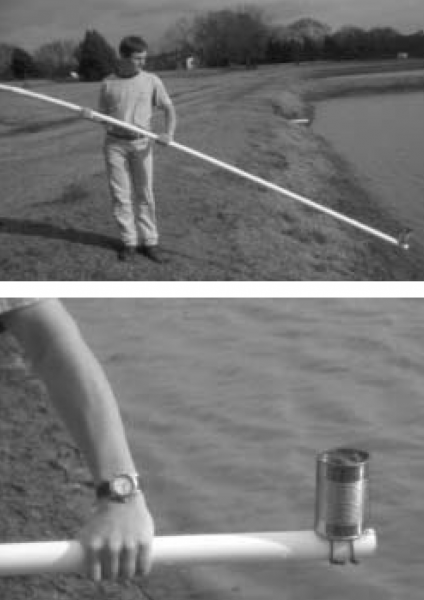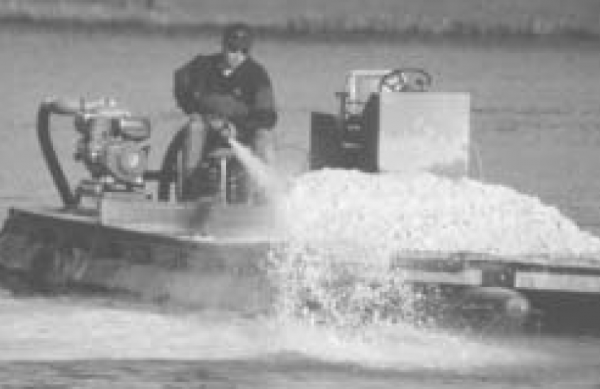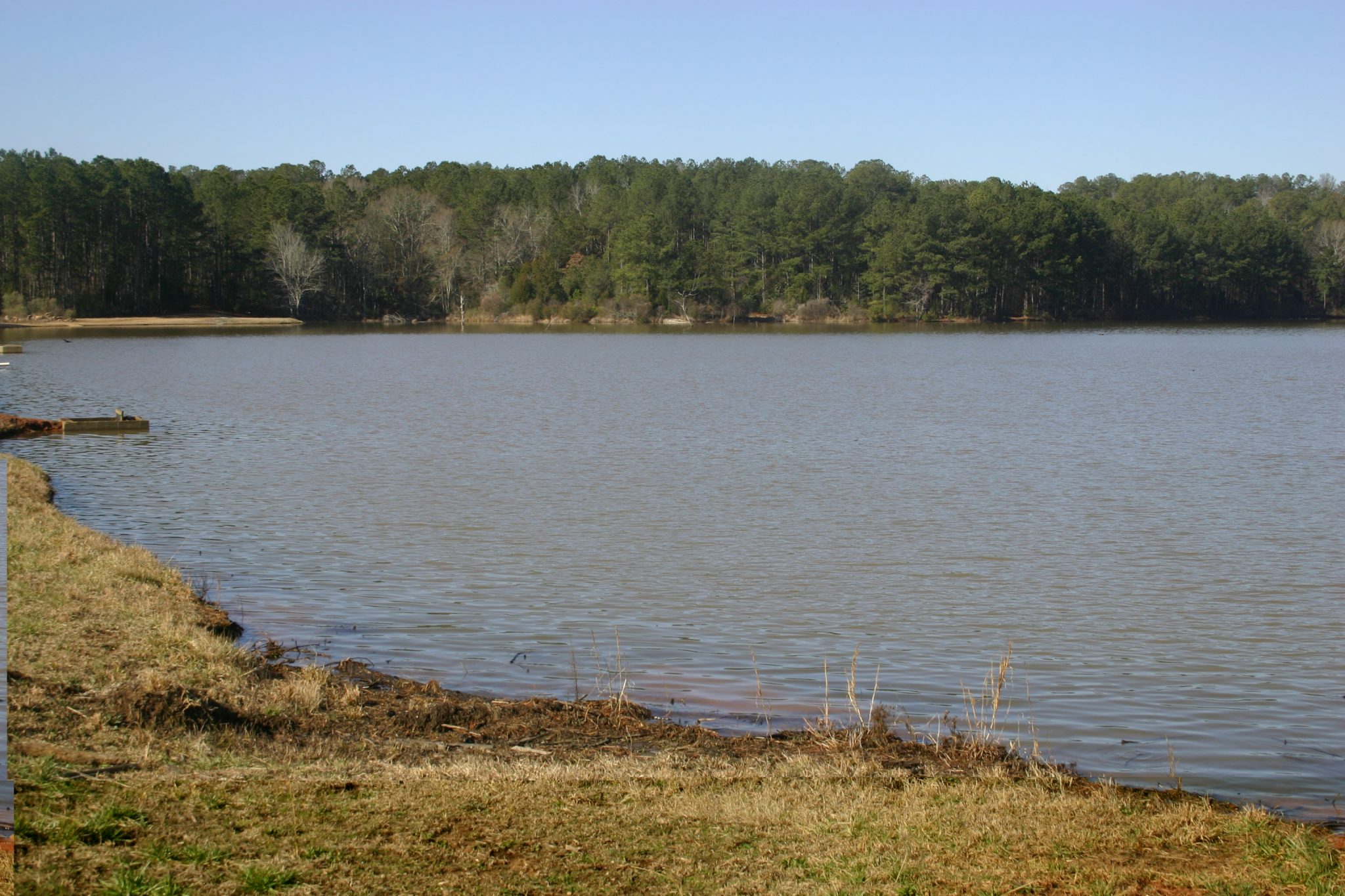Fish & Water

Adding agricultural lime to ponds with low alkalinity (less than 20 mg/l) can greatly increase productivity. Lime affects the system in several ways. Lime acts as a buffer maintaining the pH between 7 and 8.5. Broader swings in pH can be very stressful to the organisms in the pond.
Lime also changes the chemistry of the water and pond soils making nutrients more available to aquatic organisms, especially algae. Calcium from the lime is a valuable nutrient for many organisms in the pond including snails and other animals that are important food for fishes. Lime can also enhance the supply of carbon to highly productive algae.
Many ponds in Alabama collect water from watersheds with soils of very low alkalinity, the ability to neutralize acid. Exceptions are in areas of the state with significant limestone including the Black Belt region where the soils are derived from weathered limestone. Ponds with low alkalinity (less than 20 mg/l) typically respond poorly to the addition of fertilizer. Either the algae bloom never becomes dense leaving the water clear even after the addition of fertilizer or the bloom is short lived. Typically, low alkalinity ponds have very clear water. A disk lowered into the water is visible to depths greater than 24 inches (Secchi disk depth). Sometimes, the water is brown stained as well. Without productive algae, there simply is not enough food in these low alkalinity ponds for the small animals that are food for fish.
Testing for Lime Requirements

Figure 1. A simple sampler for collecting mud from a full pond
Water from ponds in areas of Alabama without alkaline soils, the majority of the state, should be routinely tested for alkalinity. A small sample of water, a pint or so, taken from the surface is adequate for the test. The sample should not contain mud from the pond bottom or large amounts of plant material; a few plant fragments will not affect the test. County Extension agents can either test the sample or provide an appropriate contact for the test. For a small fee, the Auburn University Soil Testing Laboratory can test pond bottom soils to determine the amount of lime needed. To obtain a good representation of the entire pond, several samples (3 to 6 per acre) should be taken from different areas of the pond bottom including the deep, shallow, and upstream ends as well as near the dam. Mud from deep areas of the pond can be sampled using a can attached to the end of a pole (Figure 1). Samples should be thoroughly mixed and allowed to dry completely. Place the dried, combined sample in a sample box available from your county Extension agent or the Auburn University Soil Testing Laboratory. Mail to the Soil Testing Laboratory, 118 Funchess Hall, Auburn University, AL 36849-5411. Clearly mark the sample box “fishpond.” A schedule of test prices can be obtained from the Soil Testing Laboratory (telephone: 334-844-3958). The soil analysis will provide a lime recommendation of lime in tons per acre. This amount should be considered a minimum recommended application rate.
Types of Liming Materials
The term lime is applied to a variety of substances containing one or more active ingredients in different forms. These can vary greatly in their influence on pond chemistry (Table 1). Active ingredients include burnt lime or quicklime (CaO), slaked or hydrated lime (Ca(OH)2), agricultural ground limestone in the form of either calcitic lime, primarily calcium carbonate (CaCO3), or dolomitic lime, a mixture of calcium and magnesium carbonate (CaCO3•MgCO3). Both quicklime and slaked lime dissolve rapidly in water. Quicklime, in fact, reacts violently with water releasing a tremendous amount of heat in the process. Adequate precautions should be taken when handling quicklime to prevent inhalation or contact with skin.
Table 1. Types of Liming Materials
| Lime Type | Active Ingredients | Application Rates | Recommendation |
|---|---|---|---|
| Calcitic lime | CaCO3 | At least 2 tons per acre | Recommended |
| Dolomitic lime | CaCO3, MgCO3 | At least 2 tons per acre | Recommended |
| Crushed oyster shells | CaCO3 | At least 2 tons per acre | Recommended |
| Pelletized lime | CaCO3, MgCO3 | At least 2 tons per acre | Not recommended due to high cost and potential problems with the binder |
| Fluid lime | CaCO3, Ca(OH)2 in some formulations | Depends on formulation | Not recommended due to high cost and the potential to raise pH to toxic levels |
| Lime wastes | CaCO3, Ca(OH)2 | The smaller of either 200 lb/acre or the amount required to deliver 50 lb/acre of Ca(OH)2 | Not generally recommended; this material could raise pH to toxic levels |
| Quicklime, Burnt lime | CaO | Less than 50 lb/acre | Not recommended; this material could raise pH to toxic levels with only short-term effectiveness |
| Slaked lime, Hydrated lime, Builders lime | Ca(OH)2 | Less than 50 lb/acre | Not generally recommended (see exception in the text); this material could raise pH to toxic levels with only short-term effectiveness |
Both quicklime and slaked lime can dramatically raise the pH of ponds to levels toxic to fish. The effect on both the alkalinity and pH of the pond is relatively short lived because the materials are rapidly flushed from the system. Slaked lime should only be used in ponds when alkalinity must be raised quickly. Examples would be to reverse a toxic level of copper sulfate used in algae control or to reduce the level of dissolved carbon dioxide in a period of low oxygen. Under these extreme conditions, no more than 50 pounds per acre should be applied.
Lime waste, by-products of several industries including paper production, has also been used as a liming product for agricultural fields, and it has been suggested for use in ponds. Lime wastes contain primarily calcium carbonate; however, there can be variable amounts of slaked lime mixed with this product. While lime waste can be used safely, it should be applied in relatively small amounts to avoid raising the pH to toxic levels. Because small amounts of lime waste are applied, multiple applications per year may be needed to adequately raise alkalinity. Ideally, lime waste should be analyzed to determine the percent of slaked lime so the total application to the pond can be controlled. Other alkaline by-products from industry include boiler wood ash and basic slag. These products should be tested by the Soil Testing Laboratory before application in ponds. Silicate slags should not be used in fishponds.
Unlike quicklime and slaked lime, ground agricultural limestone is not very soluble. This results in the need for more agricultural lime to be added to the pond to achieve an effect on its chemistry. Two or more tons of agricultural limestone per acre are generally applied to low alkalinity ponds. Under normal conditions, it is impossible to add too much limestone to ponds. Adding more limestone to the pond simply increases the time until lime is needed again.
Ground agricultural limestone is available in ground, fluid, and pelletized forms. Fluid lime is more expensive than the dry products and may contain slaked lime. If the active ingredient in the fluid lime is calcium carbonate, about twice as much fluid lime must be applied to achieve the same effect as finely ground agricultural limestone. Pelletized lime is calcitic or dolomitic limestone mixed with a binding agent that breaks up quickly in water. Pelletized lime is much cleaner and easier to apply than ground limestone. However, pelletized lime is far more expensive than ground lime and the binding agent can cause a brown stain in ponds. This brown stain, while not directly toxic, can increase the demand for oxygen in the pond and shade the oxygen-producing algae, thereby reducing the available dissolved oxygen for fish. Ground agricultural limestone is by far the best liming material for ponds. Ground agricultural limestone is relatively inexpensive, safe for both the applicator and fish, and provides a long-term increase in alkalinity. Ground limestone is made by finely grinding various types of limestone or mollusk shell (oysters, clams, mussels). The source of the limestone may affect the cost depending on local availability. All sources are equally effective if ground to equivalent fineness.
Methods of Application

Figure 2. Broadcast agricultural limestone from a barge.
Difficulty of application is the only drawback to the use of agricultural limestone in ponds. Application of 2 tons or more per acre to full ponds requires that the lime be spread from a barge in all but the smallest ponds (Figure 2). Without the aid of heavy machinery, spreading enough limestone to fully neutralize the soils of the pond bottom can be backbreaking work. Many private pond consultants have the proper equipment to lime large ponds for a reasonable fee. For small ponds, less than about 3 acres, the lime can be spread from the shore if the spreader can approach the pond at several points around the shoreline so the lime will contact the entire pond bottom.
The easiest time to lime a pond is before filling. With the pond dry, the spreader truck can easily apply large amounts of lime to the pond bottom and, hopefully, eliminate the need to add lime for several years.
Time of Application
Late fall and winter are the best times to correct the alkalinity of ponds so the water can support the maximum productivity in the following growing season. Applying lime in the winter allows adequate time for it to dissolve. Adding lime during the growing season also can disrupt the algae bloom by removing nutrients and algae from the water, temporarily reducing productivity and dissolved oxygen.
Further information about types of liming materials, influence of alkalinity, and use of lime in ponds can be found in Southern Regional Aquaculture Center publication 464, “Interactions of pH, Carbon Dioxide, Alkalinity and Hardness in Fishponds.”
Russell Wright, Extension Specialist, Associate Professor, Fisheries, Aquaculture, and Aquatic Sciences, Auburn University
Reviewed October 2022, Adding Agricultural Lime to Fishponds, ANR-0232

